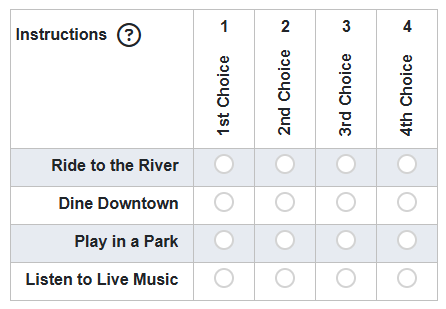Ranked Voting#
In 2022, Fort Collins voters approved a change to the City Charter requiring that beginning in 2025, the offices of Mayor and of each District Councilmember will be elected using a “ranked voting method,” pursuant to the applicable Colorado statutes or City ordinance.
Practice Ballot#
Practice using a ranked ballot to vote on your favorite activity, and see how the tallies adjust through each round of tabulation.
Ranked Voting FAQs#
General Overview#
-
Ranked-choice voting/ranked voting is a method that allows voters to rank multiple candidates in a race in their order of preference.
-
Fort Collins voters approved ranked voting in 2022 with 58.15% of the vote. The ballot language specified that it would be implemented for City Council races beginning with the 2025 municipal election.
-
Per the 2022 ballot language, Fort Collins voters will use ranked voting to elect the Mayor and all City Councilmembers in any race with three or more candidates, beginning with the November 2025 municipal election.
-
Traditionally, voting has been a system in which the candidate who receives the most votes in a race wins the election, even if that candidate did not receive a majority (50% + 1 or more) of the total votes.
Ranked voting elections allow voters to rank multiple candidates in their order of preference, with those ranked choices counted over multiple rounds to determine who wins the election. Rather than just choosing one candidate, voters can rank their first choice, second choice, third choice, and so on.
If a candidate gets more than 50% of first-choice votes, they win the race outright. If no one gets a majority, the candidate with the fewest votes is eliminated; voters who chose that eliminated candidate as their first choice will then have their votes transferred to their second-choice candidate. The process continues until one candidate receives more than 50% of the votes cast.
How it Works#
-
Ballots will be a grid, with the candidates listed in rows, and spaces for first-choice, second-choice, and so on, in columns.
First Choice Second Choice Third Choice Fourth Choice Candidate A Candidate B Candidate C Candidate D -
Step 1: Choose your top candidate. This is your first-choice candidate and will be considered first.
Step 2: If you have a second choice, you may select another candidate. This must be different from your first-choice candidate.
Step 3: If you have a third choice, you may choose another candidate, which must be different from your first and second choices. Continue making your choices for as many candidates as you prefer.
-
No. You may rank as many or as few candidates as you like. However, any choices after a skipped ranking will not be tabulated. If you mark a first choice, skip a second choice, and then mark a third choice, only your first choice will be tabulated.
-
Your vote will be counted in the first round of tabulations. If your preferred candidate receives more than 50% of the votes at any point in the tabulation process, they will win the election. However, if your preferred candidate is eliminated through any of the tabulation rounds, your choice will not move to another candidate if you have not ranked anyone else.
-
No. A voter can only choose a candidate one time. Ranking additional candidates ensures you continue to have a say in which candidate is chosen if your first-choice candidate does not receive enough votes to stay in the race. If you choose the same candidate multiple times, only the first vote cast for that person would count. It would continue to count until that candidate either wins or does not receive enough votes to stay in the race.
-
No. You cannot give more than one candidate the same ranking. Ranking two or more candidates in the same preference column would invalidate your vote because there would be no way to determine voter intent. Only one candidate can represent the voter’s first, second, third, fourth or other vote, depending on the number of candidates.
-
You do not have to rank every candidate, but if you skip a ranking, your choices after the skipped column will not count. For example, if you mark a first choice and a third choice, but not a second choice, then only your first choice will be tabulated.
-
During the first round of counting, the voting system will tabulate all first-choice selections on each ballot. If a candidate receives more than 50% of first-choice selections, they win the election outright. If no one gets a majority of the votes in the first round, tabulation will continue to a next round; the candidate with the fewest first-choice ranks is eliminated and the votes they received are transferred to the second-choice candidate indicated on each of those ballots. This process continues until one candidate receives more than 50% of ballots cast.
-
If you have selected a second-choice candidate, your vote will be moved to your second choice and added to their vote count; this process will continue until a candidate receives more than 50% of the votes cast.
-
According to the Colorado Secretary of State Election Rules, if two or more candidates tie for the lowest number or votes in a tabulation round, the designated election official will determine the eliminated candidate by drawing. If two or more winning candidates tie for the most votes in any round, the designated election official must first count the surplus votes of the candidate chosen by drawing.
-
There must be at least three candidates in a race to use ranked voting. If there are only two candidates, the winner will be whoever receives the highest number of votes.
Transparency and Implementation#
-
Ranked voting is designed to give every voter an equal opportunity to express their preferences, but not to count more than one vote per voter.
In each round of counting, only one choice per voter is counted. If your first-choice candidate is still in the running, your vote stays with them. If your first-choice candidate is eliminated, your vote transfers to your next-ranked candidate. This ensures all voters have an opportunity to express their preferences, even if their top choice doesn’t advance.
Think of it like a series of runoff elections, but instead of having to cast a new ballot each round, all of your preferences are already indicated on your ballot.
-
The accuracy of tabulation is verified both before the election (with a Logic and Accuracy Test) and after (with a Risk-Limiting Audit).
The purpose of the Logic and Accuracy Test is to verify the voting system is properly configured and programmed to accurately tabulate votes. The Logic and Accuracy Test verifies that the system correctly records all valid votes, under votes, over votes, and blank votes.
A Risk-Limiting Audit is a post-election audit that gives a statistical level of confidence that the outcome of an election is correct. In a Risk-Limiting Audit, the county examines and reports to the Secretary of State voter markings on randomly selected ballot cards, then compares them to the voting system’s tabulation as reflected in the corresponding cast vote records.
-
The process of verifying and tabulating mail ballots received up to and on Election Day can continue for several days after. In the 8 days following Election Day, the Larimer County Clerk and Recorder's Office will continue to legally receive and tabulate ballots from military and overseas voters, ballots returned in other Colorado counties, and ballots that have been "cured" (due to a missing signature, missing identification, or signature discrepancy). While ballots are still being received and processed, results are subject to change and should be considered unofficial. Election results will remain unofficial until all election processes conclude and the election has been canvassed, no later than November 26, 2025.
-
Yes. As of 2022, ranked voting methods had been adopted by more than 60 jurisdictions across the country, with more considering the move each year. It has also been used in some jurisdictions to select primary nominees for statewide or congressional races.
In Colorado, ranked voting methods have been approved for use in the City of Boulder, the City and County of Broomfield, and the towns of Basalt and Carbondale.

